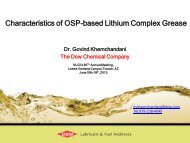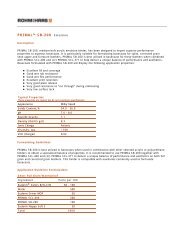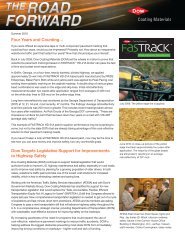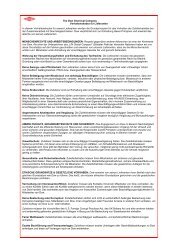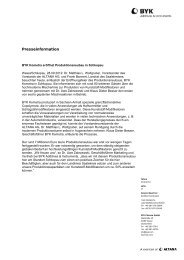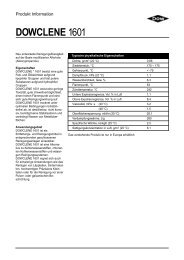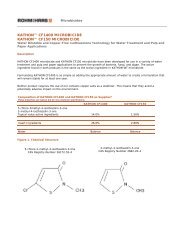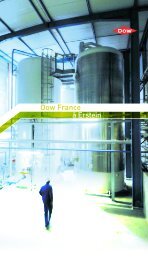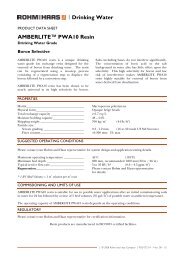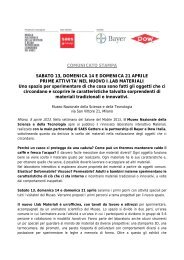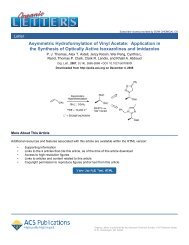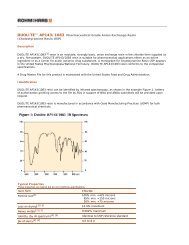Granulation with Dow Cellulosic Polymers II. High Shear Granulation
Granulation with Dow Cellulosic Polymers II. High Shear Granulation
Granulation with Dow Cellulosic Polymers II. High Shear Granulation
You also want an ePaper? Increase the reach of your titles
YUMPU automatically turns print PDFs into web optimized ePapers that Google loves.
The dry binder addition method (see<br />
Table 4) also produced tablets <strong>with</strong><br />
excellent hardness overall. The<br />
results were somewhat mixed<br />
concerning which binder level gave<br />
the harder tablets (in 5 of the 9<br />
cases, the tablets at 3% binder were<br />
harder). At the 3% binder<br />
concentration, the hardest tablets<br />
were made <strong>with</strong> the PVP (K90),<br />
METHOCEL F4P LV, HPC-LF, and<br />
PVP (K29-32) materials. Note that<br />
these are essentially the same<br />
binders and essentially the same<br />
hardness values that were obtained<br />
by the solution addition method. This<br />
was a somewhat surprising result,<br />
since it is generally considered that<br />
binders are more effective when they<br />
are placed in solution prior to the<br />
granulation operation. Similarly, at the<br />
6% level, the best binders were PVP<br />
(K29-32), PVP (K90) ≈ HPC-LF, HPC-<br />
EF, and METHOCEL K3P LV. In<br />
terms of friability, the lowest losses<br />
were predominantly from tablets<br />
containing 3% binders, namely 3%<br />
METHOCEL A15P LV, 3%<br />
METHOCEL F4P LV ≈ 3% and 6%<br />
HPC-EF, and 3% PVP (K90). The<br />
highest friabilities, which were still<br />
less than 0.50%, resulted from the<br />
use of 6% METHOCEL E15P LV<br />
and A15P LV.<br />
The statistical significance of<br />
differences in the two binder addition<br />
methods was examined. Due to the<br />
differences in the formulations, only<br />
comparisons between 3%<br />
solution/3% dry and 6% solution/6%<br />
dry were made. Of the 17 sets of data<br />
(results of the 3% METHOCEL<br />
K3P LV excluded), the dry binder<br />
addition method was statistically<br />
harder in 7 cases: 3% METHOCEL<br />
A15P LV, E15P LV, and F4P LV, 6%<br />
HPC-EF and -LF, 6% PVP (K29-32),<br />
and 3% PVP (K90). The solution<br />
binder addition method produced<br />
8 <strong>High</strong> <strong>Shear</strong> <strong>Granulation</strong>: Acetaminophen Model<br />
statistically harder tablets in 4 cases:<br />
6% METHOCEL A15P LV and<br />
E15P LV, and 3% HPC-EF and -LF.<br />
The remaining 6 cases showed no<br />
statistically significant difference in<br />
hardness between the binder addition<br />
methods.<br />
As mentioned on page 3, the<br />
formulations were compressed at<br />
1000, 2000, and 3000 lbs. total<br />
compression force. For both binder<br />
addition methods, tablet hardness<br />
increased <strong>with</strong> force <strong>with</strong> very few<br />
exceptions, those being 6% acacia<br />
(hardness was essentially constant),<br />
10% pregelatinized starch (tablets<br />
compressed at 3000 lbs. were about<br />
5 SCU softer than those compressed<br />
at 2000 lbs.), and the 3% K3P LV<br />
(solution) and 3% PVP (K29-32) (dry)<br />
tablets (which had slightly softer<br />
tablets produced at 3000 lbs.<br />
compression compared to 2000 lbs.<br />
compression). The friabilities were<br />
measured at 2, 4, and 6 minutes at<br />
each force. At a given force, the<br />
percent weight loss naturally<br />
increased <strong>with</strong> time. At a given time<br />
(e.g., 4 minutes), there was the<br />
expected decrease in friability as the<br />
compression force, and thereby the<br />
tablet hardness increased. There was<br />
a proportionally smaller decrease in<br />
friability between 2000 lbs. and 3000<br />
lbs. than there was between 1000 lbs.<br />
and 2000 lbs. There were a few<br />
cases in which the friability of tablets<br />
compressed at 3000 lbs. was greater<br />
than those compressed at 2000 lbs.<br />
despite the fact that the one<br />
compressed at the higher force had a<br />
higher hardness. One example of this<br />
behavior is 3% PVP (K29-32)<br />
(solution), where the hardness and<br />
friability at 2000 lbs. compression<br />
force were 20.9 SCU and 0.37%,<br />
while the hardness and friability at<br />
3000 lbs. compression force were<br />
21.9 SCU and 0.75%, respectively.<br />
The weight and thickness variation of<br />
the tablets for each formulation and<br />
binder addition method were also<br />
measured (n = 20). The thickness<br />
variation in all cases was excellent,<br />
varying from a low of 0.12% relative<br />
standard deviation (RSD, equal to the<br />
standard deviation/mean x 100) for<br />
the 6% METHOCEL F4P LV (solution<br />
method) formulation, to 0.84% RSD<br />
for the 3% HPC-EF (solution)<br />
formula; the range of thickness<br />
variation for the dry addition method<br />
was 0.18–0.67% RSD. Similarly, the<br />
weight variation was very good for the<br />
majority of the formulations, varying<br />
from 0.47% RSD for the 3%<br />
METHOCEL F4P LV (dry) formula, to<br />
1.39% RSD for the 6% METHOCEL<br />
E15P LV (solution) case. The binders<br />
that performed well in one of the<br />
binder addition methods tended to<br />
perform well in the other addition<br />
method as well.<br />
Tablet Dissolution Properties<br />
The in vitro dissolution properties<br />
varied both as a function of the<br />
nature of the binder and the amount<br />
of binder in the formulation, but<br />
relatively little as a function of the<br />
binder addition method. The USP<br />
dissolution conditions for<br />
acetaminophen tablets were used<br />
(Type 2 apparatus at 50 rpm, 900 mL<br />
of pH 5.8 phosphate buffer). The<br />
time to reach 80% dissolved is<br />
designated by t 80% . A number of<br />
these dissolutions are presented in<br />
Figures 10-18.



